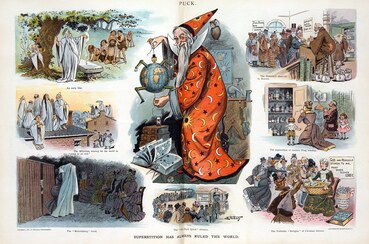|
Written By Isabela Téllez Edited By Nicholas Tan You walk down Broadway on a Fall afternoon, thinking about the Halloween costume you will choose this year. Will you be a Winx Club fairy, a sexy cowboy, or one of those giant inflatable dinosaurs? You finally decide on a sexy cowboy… then you spot a black cat staring at you as you turn the street corner. You suddenly start overthinking your costume choice. Is this a bad omen? It can’t be a coincidence that you saw a black cat at the same time that you chose the costume. Maybe sexy cowboys are bad luck. You decide to go with Winx Club’s Bloom instead. That decision was based on the superstition that black cats bring bad luck. Superstitions can be powerfully and subtly influential in our daily lives; even if you don’t think you’re superstitious, when you say “bless you” when someone sneezes, you’re invoking an old superstition that the devil can steal your soul whenever you sneeze. Why do superstitions have such a big impact on our lives, and how are they created in the first place? What made us associate black cats, broken mirrors, and open ladders with bad luck? When you think about superstitions, you might think that they have a cultural explanation rather than a scientific one. After all, superstitions are commonly perceived to be absurd beliefs. However, you might be surprised at how consistent the scientific explanation for superstitious behavior can be! While it is true that certain superstitions are associated exclusively with specific cultures or countries, there are many scientific explanations for why superstitions are formed in the first place. Superstition arises from a phenomenon known as ‘operant conditioning’. Operant conditioning was first described by the behavioral psychologist B.F. Skinner; the word ‘operant’ refers to any behavior where an organism interacts with the environment to generate a consequence, and ‘conditioning’ is the process of training an organism to behave a certain way. In other words, it is a method of learning in which an animal or person learns to associate rewards and punishments with specific behaviors. For instance, training a dog to sit by giving it a treat every time you blow a whistle, taking a child’s Xbox away because of bad grades, or giving an employee a bonus for their work are all examples of operant conditioning. In each case, someone learns to demonstrate a behavior (to sit, to get better grades, or to keep working hard) because either a reward or a punishment was given. Even if we don’t realize it, we undergo operant conditioning every day, and that is the reason why we learn to pay our rent on time (you would be punished with a late fee if you didn’t) or to study before a test (you would be rewarded with good grades). However, sometimes behaviors and rewards accidentally occur at the same time even though they are not related, and this is called accidental reinforcement. For example, when your dog jumps on you and you react by telling him to stop and giving him attention, you’re accidentally reinforcing this behavior because your dog got what he wanted and will likely repeat this behavior in the future. Skinner found a very interesting way of demonstrating how operant conditioning and accidental reinforcement might be the reason behind the creation of superstitions. In one experiment, Skinner placed several pigeons in individual cages (called Skinner’s boxes) and gave them each a pellet of food every 30 seconds, without the bird having to actually do anything to receive the food. After several minutes, he noticed that the pigeons were displaying very distinct and repetitive behaviors. One was running around the cage in circles, another thrusting its head at the same corner of the cage over and over, and yet another seemed to be pressing an “invisible lever” by tossing its head up and down. None of these behaviors had occurred before presenting the pellets – it seemed that the pigeons thought that they were receiving the pellets because they were repeating whatever action they were performing at the moment of receiving the first pellet. In other words, if a pigeon was walking around in circles when the pellet was delivered, it would decide to continue walking around and around. As it received more and more pellets at 30-second intervals, the pigeon would grow increasingly convinced that its walking pattern was being rewarded with food. Thus its behavior would be ‘accidentally reinforced’, even though the pellets’ delivery was not dependent on its actions at all. Does this sound familiar? Perhaps one time you wore a random pair of socks when taking a test and you aced it, and so they became your lucky socks. You now wear them to every test you take, and since you tend to ace more tests than fail them, you attribute your “luck” to the socks, even if you’re just a good student. We might never notice how the accidental reinforcers in our lives lead us to have questionable beliefs, but we are very firm in following them. This is why people have lucky charms, lucky jersey shirts, and lucky numbers that they will swear by without question. This shows how powerful operant conditioning can be in our everyday lives, and how our superstitions can be based on mere coincidences that we might never be aware of. After reading this, however, I hope that next time you see a black cat on a Halloween afternoon you don’t fret and perhaps even see it as a sign of good luck, for such a coincidence is nothing to be superstitious about.
2 Comments
Arturo
10/31/2022 04:21:21 pm
What an interesting insight into operant conditioning! It’s amazing to think how many of our actions are influenced by this seemingly unconscious phenomenon. Great article!
Reply
Leave a Reply. |
Categories
All
Archives
April 2024
|



